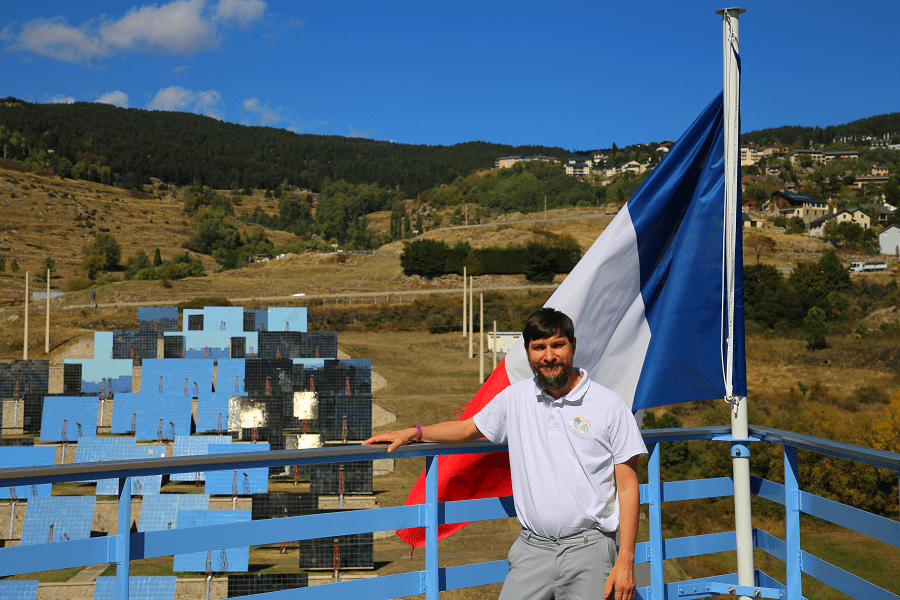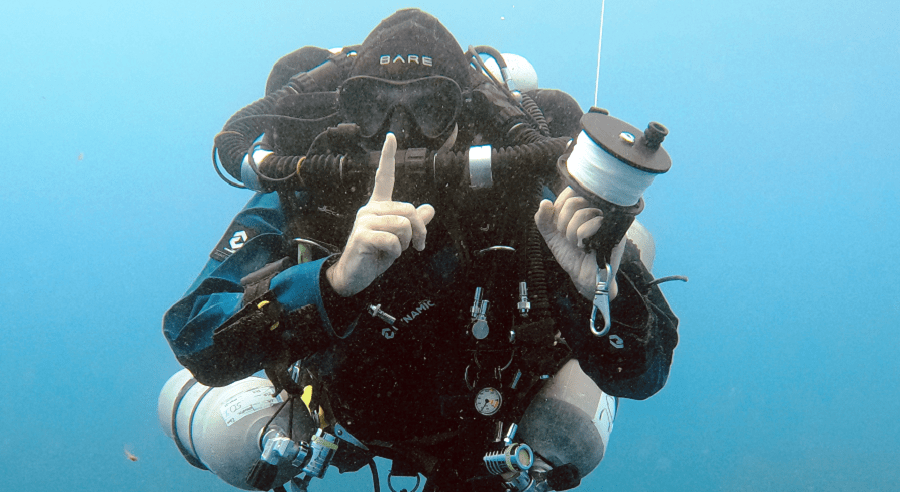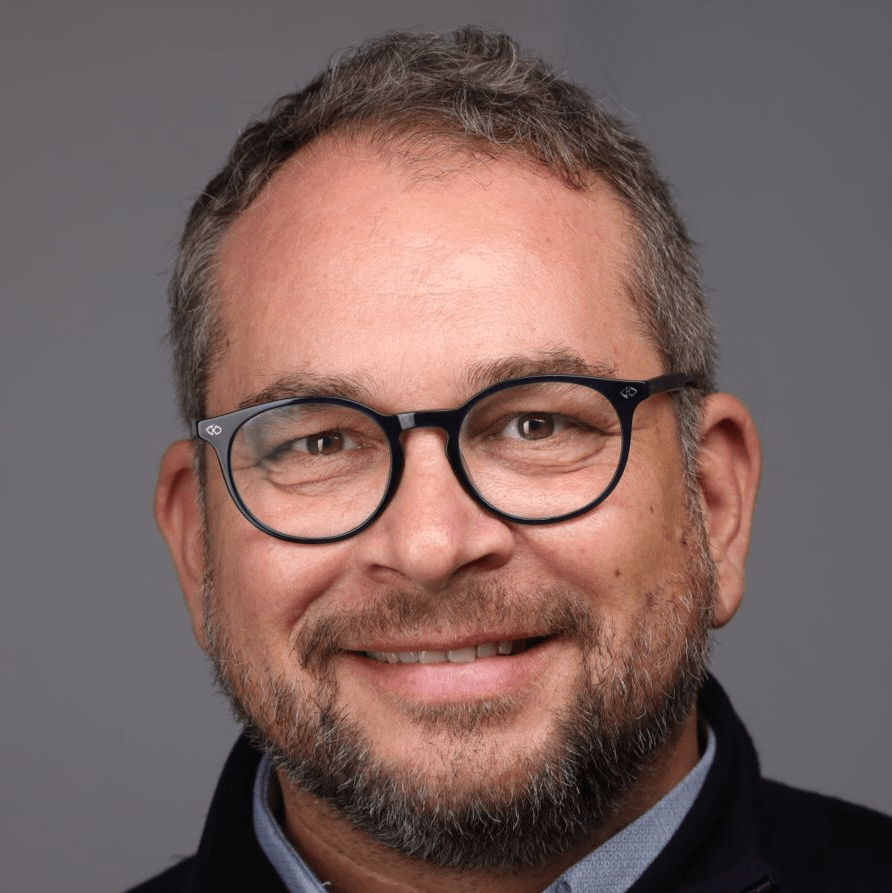Emmanuel Guillot – Director of the solar furnace laboratory at Font-Romeu-Odeillo, Occitanie, France (Font-Romeu, Pyrenees), Master of Engineering – explained the main functions of these furnaces and shared his point of view on the development of solar energy around the world.
Could you tell us about the history of the solar furnace? How was the idea conceived?
The Odeillo solar furnace was founded by Félix Trombe, a French chemist, physicist, speleologist, and one of the pioneers of solar energy in France. He began working on experiments with the concentration of light rays in 1947 using a large air defense searchlight.
At the end of the Second World War, Félix Trombe – together with Marc Foex and Charlotte Henry la Blanchetais – began to study materials using what was available on hand. The projector had a lamp and a parabolic reflector. It turns out that to illuminate an airplane from a distance of 5 to 10 km, you need a reflector with a shape almost identical to that of the sun, which is very far away from us. He succeeded in obtaining authorization to use this military equipment. This is what you can see in Batman – it’s the same projector!
In 1949, Félix Tromb led the prototyping of the 50-kW solar furnace at Mont-Louis in the Pyrénées-Orientales, and then in 1962, he created the large 1,000 kW furnace at Odello. The furnace is best known for its research into the very high temperatures associated with solar energy.
How does it work? What exactly generates so much solar energy?
When sunlight hits the mirrors, it concentrates in a small point with a temperature of 3,000 degrees Celsius. Any object made of combustible material that touches this spot instantly ignites, and pieces of heat-resistant steel melts in a matter of seconds.
The principle of reflection are used – the rays are concentrated by reflecting mirrors. A solar oven uses two different sets of mirrors to perform the two necessary optical functions: collecting, or capturing, and then concentrating the sun’s energy.
The sun’s rays are first reflected by a first set of mirrors – the “heliostats” – and then sent to a second set of mirrors, the “concentrators” that arranged on a parabola. It then converges on a near-circular target at the top of a central tower.
The sunspot concentrated on this target is about 1 m in diameter and at its center has been measured to have a power equivalent to “10,000 suns” or 10,000 kW/m2.
Do you cooperate with other countries?
The Americans wanted to build a solar furnace of a similar size to test materials used in aviation and other civil applications. But they finally chose to come and work here. In particular, they tested materials used in the nuclear industry. The NASA Space Shuttle’s atmospheric re-entry shield was also tested here in the 1970s.
The Soviet Union built a similar solar furnace, which is now in Tashkent, Uzbekistan. An exchange of information took place between France and the Soviet Union, which did not please the Americans.
So, there are only two facilities of this type in the world: in Font-Romeu and in Uzbekistan. But the tower we have here is unique compared to any others in the world. There is no equivalent, no competition, no similar experience.
What exactly do you work on here?
Our work is mainly focused on the study of materials and in particular, their response to heat. This is an example of our global work. In addition, the furnace aims to use solar energy and is therefore part of the larger energy transition to decarbonize the economy.
We are also developing applications for the construction industry – for example, walls that act as a heating system.
The Odeillo Center stores solar energy. We have many different heat storage systems. The furnace also allows us to do much more efficient, cost-effective, and compact activities like chemical experiments or melting plastics.
Currently, the scientific structure of the lab includes three research topics: materials for space, next-generation solar power plants, and solar energy storage (including thermal storage, photochemistry, industrial solar heat, synthetic fuels, etc.).
Public and private companies often come to us to work on special projects. There are, for example, companies that are interested in manufacturing bricks at 500-600 degrees Celsius, and they can come and utilize our existing facilities, i.e. solar energy.
With our solar facilities, we can provide temperatures from 20 degrees to 1,500 degrees and even 2,000 degrees.
Can the furnace supply energy to a small town the size of Font-Romeu, for example?
The research laboratory produces electricity, but that’s not our job. We’re not the ones supplying power to Font-Romeu.
Who funds your laboratory?
This is the National Center for Scientific Research (le Centre National de la Recherche Scientifique, CNRS), whose mission is to identify, carry out or commission (alone or with its partners) any research of interest to the advancement of science and the economic, social, and cultural progress of the country. It is the main research organization in France.
It reports to the French Ministry of Higher Education and Research. The CNRS contributes to the influence of French research throughout the world through its 80 international laboratories and its 8 representative offices abroad: Washington DC, Brussels, Rio de Janeiro, Pretoria, New Dalí, Beijing, Tokyo, and Singapore.
The CNRS is comprised of 32,000 staff, 1,000 research units and a budget of €3.4 billion (not including research expenditures).
All scientific disciplines are covered by the CNRS, which is divided into 10 directorates – including chemistry, biology, astronomy, mathematics and the humanities (history, linguistic sciences, social sciences, etc.).
Do you work with universities? Do students often come to you for work placements?
Yes, we work with many students from around the world. Quite a few of them are French, and they are mainly European from Spain, Germany, Italy, England, and so on. We also have colleagues from other parts of the world such as Japan, the USA, etc. Colleagues from universities and students sometimes come for 6 months to work with us.
And why was the oven created in the Pyrenees?
After the Second World War, two locations were considered: either Provence or the Pyrénées Orientales. The Cerdan plateau is like a fortified castle with mountains all around. The clouds tend to surround us, but they don’t often penetrate the castle!
What’s more, we benefit from the altitude: the atmosphere is pure, healthy, and dry. The quality of the sun is more or less the same as in the south of Spain.
What were the main discoveries you made here?
We don’t work for businesses. We work on a theoretical scale of the realm of ideas. The Trombe Wall is a classic technique in architecture for using solar energy to heat rooms. We also have extensive experience in the synthesis of paraffins.
We have the means to produce nanomaterials, and these materials can be used to improve the performance of certain electronic components. We have the capacity to test and manufacture new materials and verify their performance here.
What do you think of the development of solar energy in general? How competitive is its use?
Solar energy development has boomed in recent years. The use of photovoltaic panels to produce electricity is becoming increasingly widespread, because it’s less expensive to produce kilowatts using solar energy. In France, the share of photovoltaic panels in national production is low, but in China, for example, it is enormous. The weakness of photovoltaic panels is that once the electricity has been produced, it is difficult to store large quantities of energy. That’s why, in France, this issue is the subject of much debate.
How do you see the use of solar energy developing?
With the help of mirrors, we can create heat and it’s much simpler compared with photovoltaic panels. If we use mirrors, we use half as much land, and we produce twice as much than production with photovoltaic panels.
For global energy autonomy, concentrated solar power is invaluable. We can cover all the energy needs of a large country with the help of the local industry.
Are you open to tourists?
The CNRS sometimes organizes science days for schools, but the laboratory is not open to tourists. We used to have a free outdoor exhibition open to everyone to explain what the furnace is used for. Perhaps in 2024-25 we’ll be able to welcome the general public again.











